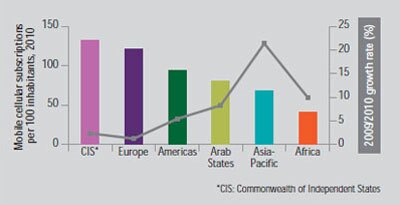During the first decade of the 21st century, information and communication technologies (ICTs) came within reach of most of the world's people. As part of World Statistics Day, the United Nations commissioned the International Telecommunications Union (ITU) for current data and statistics on ICTs. The resulting report: The World In 2010: ICT Facts and Figures provides an insight into just how phenomenal the growth of ICTs have been over the past few years.
According to the ITU, internet users have grown from under 400 million in the year 2000 to having now surpassed 2 billion. The world now has an estimated 5.3 billion mobile subscriptions, with 90 percent of the world's population having access to a mobile network. Over 6.1 trillion text messages were sent in 2010 – that's 200,000 text messages every second!
The mobile market in the developed world, which the UN commonly refers to as being North America, Europe, Japan, Australia and New Zealand, is reaching saturation levels with an average of 116 subscriptions per 100 people. The Asia-Pacific region is experiencing strong growth in mobile subscriptions chiefly due to India and China adding over 300 million subscriptions in 2010. Developing countries are estimated to have 76 percent of the world's mobiles, up from 53 percent at the end of 2005. Of the world's 5.3 billion mobile subscriptions, 17 percent are 3G connections.

Looking at the global picture, one in three of the world's population is now online. The ITU says the number of people online has doubled in the last five years to exceed two billion, of which 60 percent are in developing countries. China has the most internet users with more than 420 million people connected, while 65 percent of Europeans are online compared to 9.6 percent of Africans. The emergence of 3G networks and now next-generation wireless (4G) networks are expected to progressively allow developing countries to access the internet where fixed broadband infrastructure is limited.
The ITU reports that an estimated 1.6 billion people have internet access at home, with an estimated 555 million wired broadband connections globally. Demand for higher speed connections is rising with more and more high bandwidth content and applications available driving further demand. In the developed world, 65 percent of households are online. In some countries, namely South Korea, the Netherlands and Sweden, more than 80 percent of homes have internet access, and virtually all of these connections are broadband. In the developing countries 15.8 percent of households are connected, with 4.4 percent of these connections broadband. In Africa, less than one percent of internet connections are wired broadband.
There are still large differences between countries when talking about broadband affordability, especially those countries with lower per capita incomes, and this is certainly affecting subscriber levels. An entry level wired broadband connection in a developing country costs on average 190 PPP$ per month as opposed to 28 PPP$ per month in developed countries (PPP stands for Purchasing Power Parity and is a is a theory of long-term equilibrium exchange rates based on relative price levels of two countries).
The ITU asserts over 80 countries, including Australia, Afghanistan, Chile and the United States, had adopted or plan to adopt a national broadband strategy. These policies focus on building nationwide broadband infrastructure with the plan to provide public services online, including e-health, e-education and e-government. The ITU claims that over 40 countries now include broadband in their universal service/universal access definitions and a number of countries, including Estonia, Finland and Spain, have already declared access to the internet as a legal right for their citizens.
If you'd like to bury your head in some more mind-boggling facts and figures, The World In 2010: ICT Facts and Figures report is available as a free download from the ICT.










